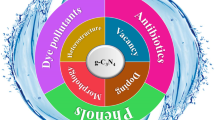Abstract
BiFeO3/BiOCl (BFO/BOC) nanocomposite has been synthesized through a simple chemical etching method using hydrochloric acid. XRD and HRTEM results indicated that part of BiFeO3 transformed to BiOCl, and BiFeO3/BiOCl nanocomposite was successfully prepared. The bandgap values of the prepared BiFeO3 and BiOCl sample are estimated to be 2.23 eV and 3.65 eV using ultraviolet–visible absorption spectra. There are two prominent photo absorption bands for the BFO/BOC heterostructures, which is assigned to the absorption of BiOCl and BiFeO3, respectively. SEM results showed that BFO/BOC sample composes of irregular BiFeO3 nanoparticles and plate-like BiOCl particles. Compared to BiFeO3, the photocatalytic degradation rate of rhodamine B (Rh. B) and phenol over BFO/BOC increase by 32% and 9%. Electron transfer mechanism analysis reveals that indirect dye photosensitization of BiOCl plays the leading role on the enhanced visible light driven photodegradation of Rh. B.






Similar content being viewed by others
References
D.S. Rana, I. Kawayama, K. Mavani et al., Understanding the nature of ultrafast polarization dynamics of ferroelectric memory in the multiferroic BiFeO3. Adv Mater 21, 2881–2885 (2009)
T. Xian, H. Yang, J.F. Dai et al., Photocatalytic properties of BiFeO3 nanoparticles with different sizes. Mater Lett 65, 1573–1575 (2011)
M.Y. Shami, M.S. Awan, M. Anis-ur-Rehman, Phase pure synthesis of BiFeO3 nanopowders using diverse precursor via co-precipitation method. J Alloy Compd 509, 10139–10144 (2011)
F. Gao, X.Y. Chen, K.B. Yin et al., Visible-light photocatalytic properties of weak magnetic BiFeO3 nanoparticles. Adv Mater 19, 2889–2892 (2007)
C.X. Hao, F.S. Wen, J.Y. Xiang, H. Hou et al., Photocatalytic performances of BiFeO3 particles with the average size in nanometer, submicrometer, and micrometer. Mater Res Bull 50, 369–373 (2014)
J.J. An, L.H. Zhu, Y.Y. Zhang, H.Q. Tang, Efficient visible light photo-Fenton-like degradation of organic pollutants using in situ surface-modified BiFeO3 as a catalyst. J Environ Sci 25, 1213–1215 (2013)
I. Papadas, J. Christodoulides, G. Kioseoglou, G. Armatas, A high surface area ordered mesoporous BiFeO3 semiconductor with efficient water oxidation activity. J Mater Chem A 3, 1587–1593 (2015)
N. Zhang, D. Chen, F. Niu et al., Enhanced visible light photocatalytic activity of Gd-doped BiFeO3 nanoparticles and mechanism insight. Sci Rep-UK 6, 26467 (2016)
D. Chen, F. Niu, L. Qin et al., Defective BiFeO3 with surface oxygen vacancies: Facile synthesis and mechanism insight into photocatalytic performance. Sol Energ Mat Sol C 171, 24–32 (2017)
R. [Guo, L. Fang, W. Dong et al., Enhanced photocatalytic activity and ferromagnetism in Gd doped BiFeO3 nanoparticles. J Phys Chem C 114, 21390–21396 (2010)
R. Tao, C. Shao, X. Li et al., Bi2MoO6/BiFeO3 heterojunction nanofibers: Enhanced photocatalytic activity, charge separation mechanism and magnetic separability. J Colloid Interf Sci 529, 404–414 (2018)
K.L. Zhang, C.M. Liu, F.Q. Huang et al., Study of the electronic structure and photocatalytic activity of the BiOCl photocatalyst. Appl Catal B-Environ 68, 125–129 (2006)
M.L. Guan, C. Xiao, J. Zhang et al., Vacancy associates promoting solar-driven photocatalytic activity of ultrathin bismuth oxychloride nanosheets. J Am Chem Soc 135, 10411–10417 (2013)
S.Y. Chai, Y.J. Kim, M.H. Jung et al., Heterojunctioned BiOCl/Bi2O3, a new visible light photocatalyst. J Catal 262, 144–149 (2009)
L. Shan, Y. Liu, H. Chen et al., An α-Bi2O3/BiOBr core–shell heterojunction with high photocatalytic activity. Dalton Trans. 46, 2310–2321 (2017)
M.A. Butler, Photoelectrolysis and physical properties of the semiconducting electrode WO2. J Appl Phys 48, 1914–1920 (1977)
Y. Xu, M.A.A. Schoonen, The absolute energy position of conduction and valence bands of selected semiconducting minerals. Am Mineral 85, 543–556 (2000)
Acknowledgements
This work was supported by the National Natural Science Foundation of China (no. 11747069), Science and Technique Program of Henan Province (no. 182102210375), Foundation of Henan Educational Committee (no. 19A140010) and Doctoral Research Funding of Henan Normal University (no. 5101029170290).
Author information
Authors and Affiliations
Corresponding authors
Electronic supplementary material
Below is the link to the electronic supplementary material.
Rights and permissions
About this article
Cite this article
Shang, J., Chen, H., Chen, T. et al. Photocatalytic degradation of rhodamine B and phenol over BiFeO3/BiOCl nanocomposite. Appl. Phys. A 125, 133 (2019). https://doi.org/10.1007/s00339-019-2437-8
Received:
Accepted:
Published:
DOI: https://doi.org/10.1007/s00339-019-2437-8




